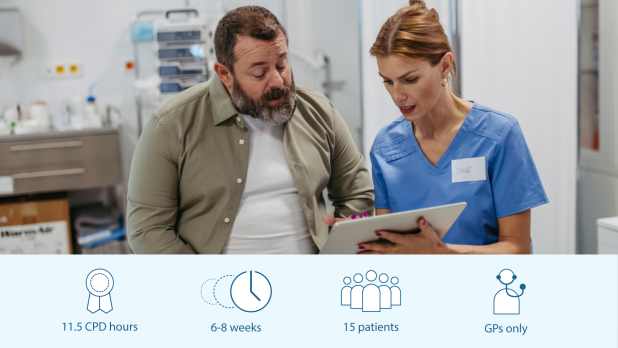
Clinical audit: Diabesity - managing obesity and overweight in people with T2D
You need to login to participate in this QI program.
Please log in, or if you don't already have a free account, register to continue.
This education is accredited: RACGP 11.5 CPD, ACRRM 11.5 CME PD.
Activity aim
In this two-part clinical audit, you will review your past management of patients with type 2 diabetes and overweight or obesity, then utilise your learnings to guide effective glycaemic and weight management of further patients.
Why take part in this program?
- In Part 1, conduct a retrospective audit of 10 patients with T2D to assess whether you are covering important points related to weight management and setting individualised weight management goals in those with overweight or obesity.
- In Part 2, conduct consultations with 5 patients with T2D who are overweight or obese, assess how their individual factors guide optimal treatment and develop a plan for achieving and maintaining their glycaemic and weight management goals.
- Earn 11.5 CPD hours on completion.
Learning outcomes
- Proactively identify patients in your practice with type 2 diabetes (T2D) with obesity ("diabesity“).
- Develop strategies to address diabesity by addressing shared physiological mechanisms.
- Implement appropriate weight management options based on the patient’s needs, in a multidisciplinary setting.
- Apply updated T2D guidelines to provide a holistic, person-centred approach to diabesity management.
Inclusion criteria
Patients who are eligible for this part 1 of this audit are:
- Aged 18 years or older
- Diagnosed with type 2 diabetes
- HbA1c > 7.0%
- Identified to be overweight or obese*
Additional criteria for part 2 of this audit are:
- Currently being treated with first-line metformin
- Have NOT previously been identified to have any of the following:
- established atherosclerotic cardiovascular disease (ASCVD; e.g. myocardial infarction, stroke, any revascularisation procedure)
- heart failure
- chronic kidney disease
*For most populations, overweight refers to a BMI of 25.0-29.9 and obesity refers to a BMI of 30 or greater.
However, population-specific BMI ranges, 23.0-27.49 for overweight and 27.5 or greater for obesity, apply for the Asian population and are recommended for the Australian Indigenous population, as per the 2022 Australian obesity management algorithm.
How long should it take?
The program has been designed to take approximately 6-8 weeks to complete. This includes the retrospective review activity, followed by patient recall from your practice, patient consult, reflection and evaluation.
This activity is sponsored by Eli Lilly.
| Clinical audit: Diabesity - Predisposing activity |
| Clinical audit: Diabesity - Education |
| Clinical audit: Diabesity - Part 1 introduction |
| Clinical audit: Diabesity - Part 1 patient entry |
| Clinical audit: Diabesity - Part 1 review and reflection |
| Clinical audit: Diabesity - Part 2 patient entry |
| Clinical audit: Diabesity - Reflective activity |
| Clinical audit: Diabesity - Reinforcing activity |
| Clinical audit: Diabesity - Evaluation |

